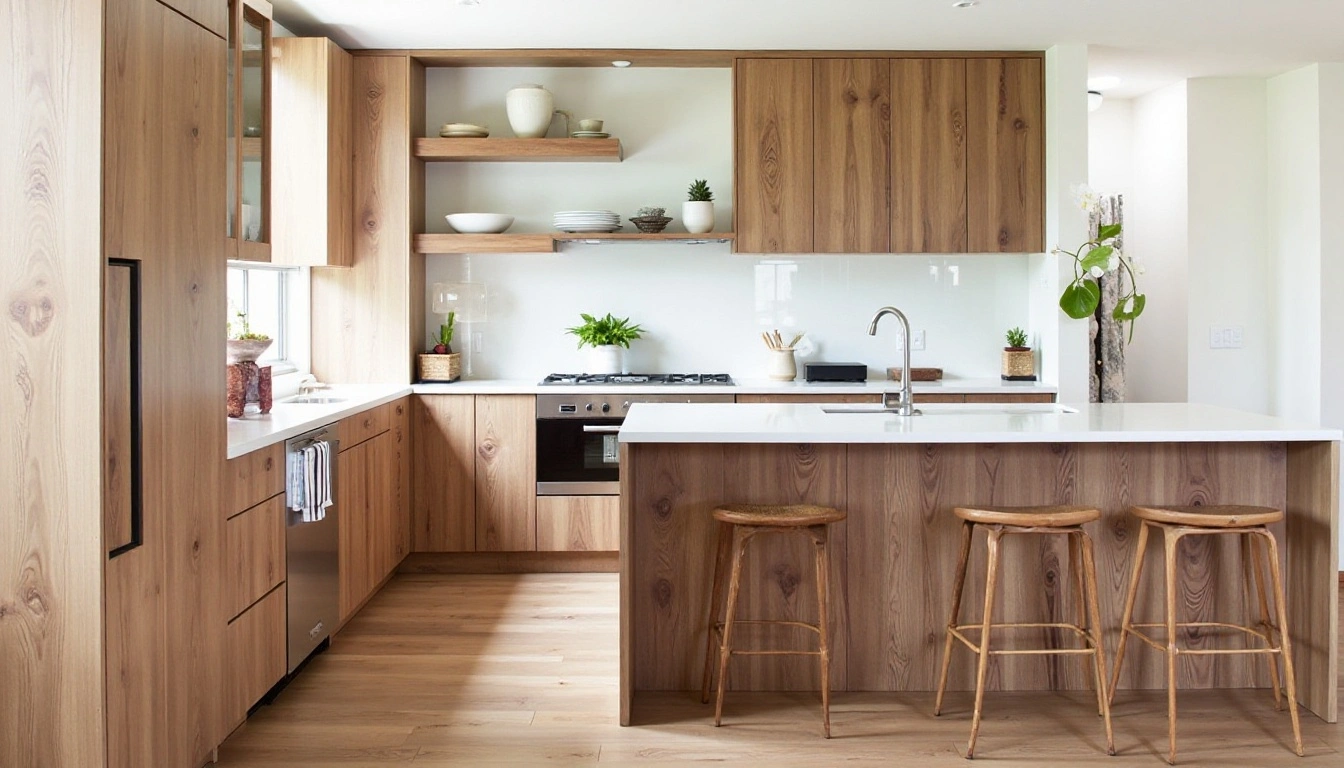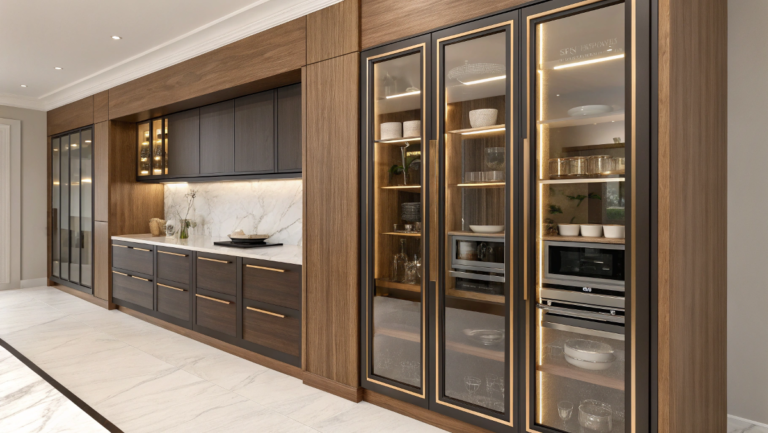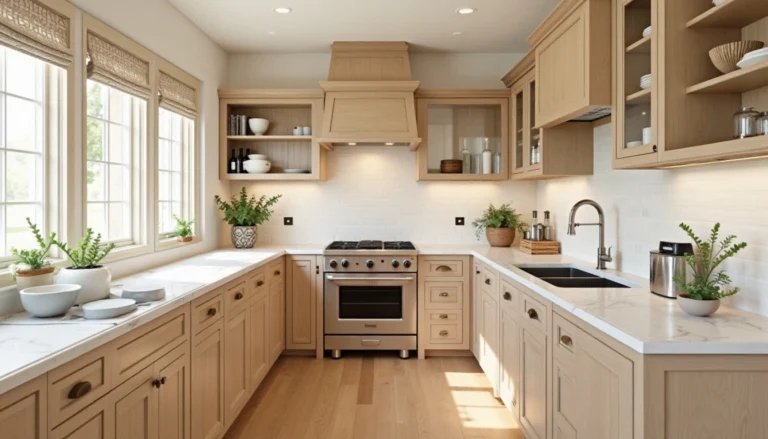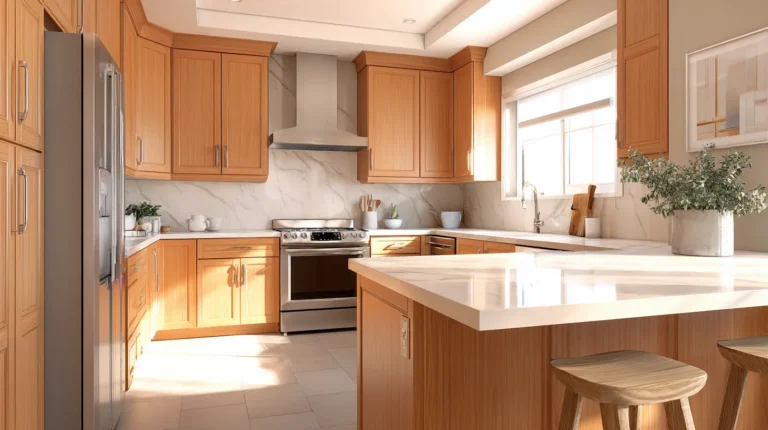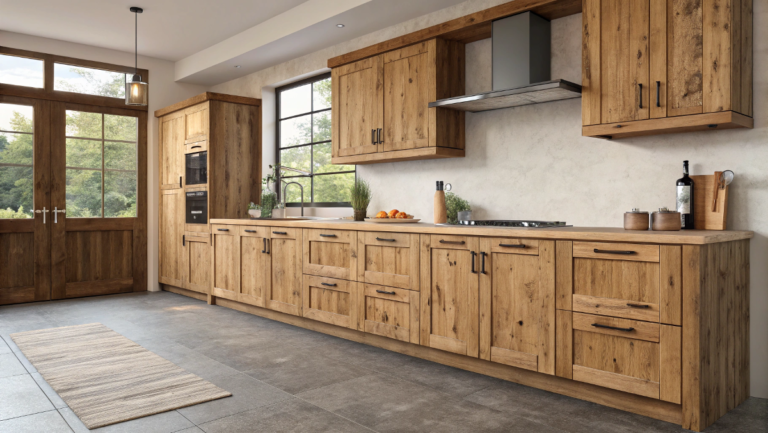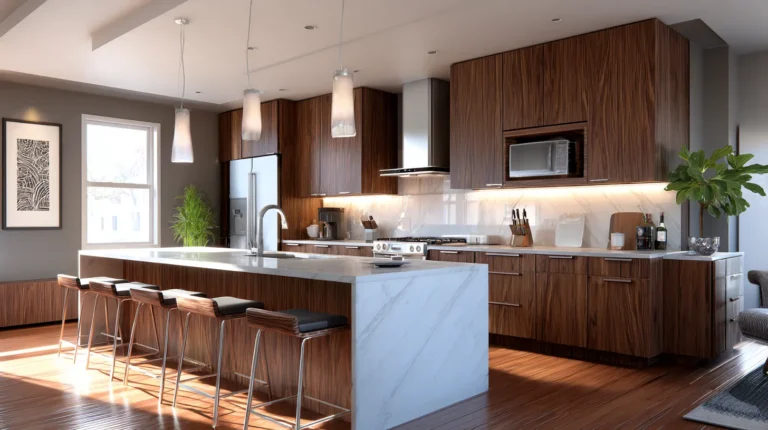best natural walnut kitchen cabinets for modern homes
Natural walnut kitchen cabinets have quietly become the go-to for homeowners who want modern style with a touch of warmth. I get it—after sanding and rehabbing more cabinets than I can count, I’ve learned that walnut brings just the right balance of elegance and effortlessness.
It’s not about show-off luxury. It’s about texture, grain, and that “lived-in but lovely” feel. Whether you’re redesigning a whole kitchen or swapping out fronts on a budget, walnut works—and in this guide, I’ll walk you through how.
Why Natural Walnut Works for Modern Kitchens
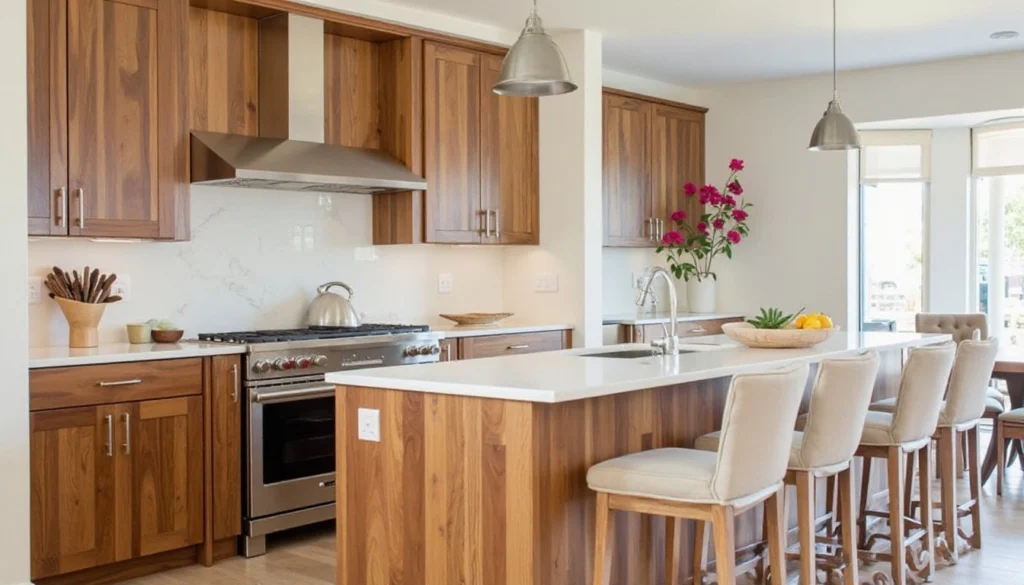
Here’s the thing: I didn’t expect to love walnuts. I thought it’d feel too formal, too dark, maybe a little too “dad’s office” for a kitchen. But the first time I saw natural walnut used in a clean, modern space, paired with flat white walls and matte black pulls, it clicked. It felt grounded. Alive, even.
Natural walnut kitchen cabinets have this quiet, lived-in elegance that modern kitchens often miss. The grain? Never repetitive. The tone? Somewhere between a cup of coffee and a warm hug. You can’t fake that with laminate or engineered wood.
And for all its richness, it’s surprisingly flexible. I’ve seen it shine in tiny galley kitchens just as much as in open-concept spaces. The trick isn’t to fight the dark tones—it’s to balance them. Think light countertops, good under-cabinet lighting, maybe open shelves up top so things don’t feel too heavy.
Oh, and bonus: walnut ages well. Like, really well. The color mellows slightly over time, softens with use, and picks up this subtle patina that feels personal. It’s not perfect—it scratches more easily than oak—but I’d take that trade any day for the warmth it brings.
Is natural walnut too dark for a small kitchen?
Only if everything else is dark too. Keep your walls light, maybe go with no uppers or frosted glass, and use warm LEDs. Honestly? It can make a small space feel cozy instead of cramped.
Modern Design Ideas with Walnut Cabinets
If you’re into that modern-minimalist-meets-warmth look (same here), natural walnut is your secret weapon. It does this thing where it grounds the space—adds texture and weight—but doesn’t demand attention. The vibe is “effortless design,” not “trying too hard.”
Scandinavian-Inspired Simplicity
One of my favorite looks: light walnut cabinets, matte white walls, soft gray counters, and maybe open wood shelves to match. Add brass or flat black hardware and you’ve got that cozy-clean aesthetic. It’s warm, but not fussy. Bonus? It’s super forgiving for families—nothing shows fingerprints like a glossy white door.
Bold & Clean with Black Accents
For something a little edgier, pair walnut lowers with black uppers or go full slab walnut cabinets and bring in black lighting fixtures, faucet, and hardware. Throw in a crisp white quartz counter and you’ve got contrast that feels sharp, not stark.
Two-Tone Sophistication
I’ve seen (and maybe pinned…) some dreamy combos where natural walnut is used just on the lowers or island, while the uppers are white, cream, or even pale green. It keeps the space light while still adding character—and it’s easier to commit to than going full-walnut everything.
Can I mix walnut cabinets with painted ones?
Absolutely. Just keep undertones in mind—walnut plays best with warm whites, creams, soft greens, or pale greys. Cool tones like icy blue or stark white can feel a bit off unless you balance with warm lighting and textures.
Choosing the Right Walnut Cabinets
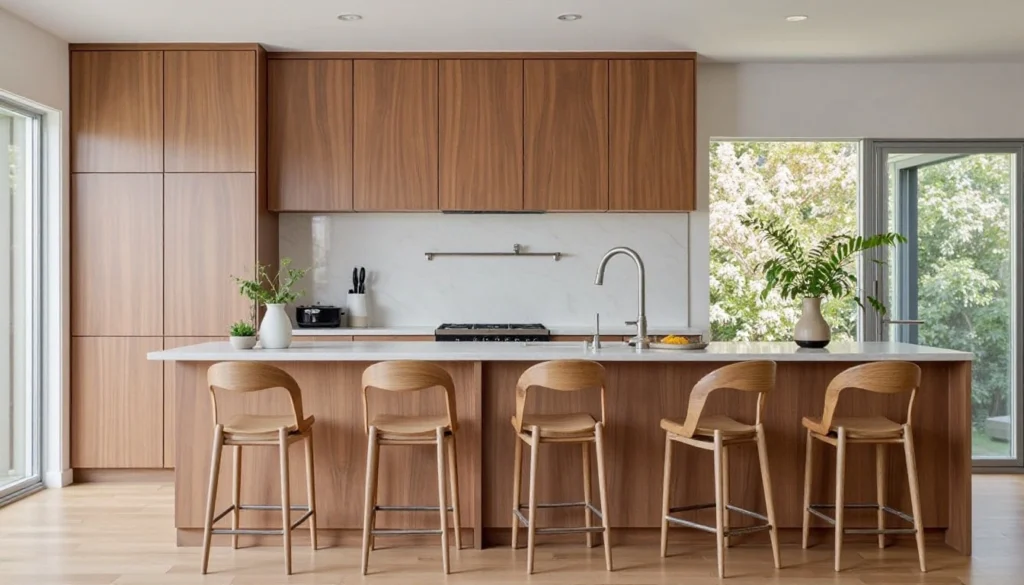
Okay, let’s pause here—because if you’ve ever browsed “walnut cabinets” online, you already know: there’s walnut, and then there’s walnut. The first time I held two samples side by side, I actually laughed. One looked like a deep espresso, the other like faded driftwood. Same wood, totally different feel.
So yeah, picking the right walnut for a modern kitchen isn’t just about style—it’s about understanding what you’re getting into.
Heartwood vs. Sapwood: The Dealbreaker No One Warns You About
If I could give one piece of advice? Ask about sapwood. It’s the lighter outer layer of the tree—and it shows up a lot in budget cabinetry unless you’re careful. Don’t get me wrong, some people love the contrast. But if you’re going for a clean, unified look? You want mostly heartwood. That’s where the rich, velvety tones live.
And here’s a little insider thing: good suppliers will grain-match panels across drawers or doors, so everything flows. If they don’t offer that? Red flag.
Flat vs. Fancy: Why Modern = Simple
For modern spaces, I always lean slab. Flat-panel walnut doors just look cleaner—more intentional. Shaker style works too if you want a hint of texture, but anything more ornate starts to compete with the wood grain. And honestly, walnut doesn’t need help being beautiful.
Stain or No Stain? (Please, Just… Don’t)
This part is personal. But I’ll say it anyway: don’t stain walnut. Every woodworker I’ve ever met has said the same thing—”clear coat or nothing.” Pigmented stain flattens that gorgeous grain and hides what makes walnut feel real. Go with a matte or satin finish that lets the tone breathe.
How can I tell if a cabinet maker is using good walnut?
Ask to see photos of past work with natural finish only. Sapwood will show. You’ll be able to spot grain inconsistencies, too. Bonus points if they’ll send you samples from the same lot your cabinets will come from. Lighting matters too—always check them under your actual kitchen lights. Learned that one the hard way.
Styling Around Walnut
If you’re wondering what actually works with natural walnut cabinets, you’re not alone. I stared at mood boards for weeks, trying to figure it out—wanting that “effortless” modern look, but unsure what played nice with all that warm, bold wood. Turns out? Walnut is a lot more flexible than people think.
Countertops: Keep It Light, Keep It Simple
White quartz is the go-to for a reason. It bounces light, makes the walnut pop, and doesn’t fight the grain. I’ve also seen pale concrete look amazing, especially in open-concept spaces where you want that smooth, low-contrast vibe. Marble’s stunning, too, but let’s be honest: it’s a commitment.
Backsplashes That Don’t Scream
Zellige tiles are kind of the MVP here. Their soft sheen and imperfect edges pair beautifully with walnut’s organic texture. I’ve used a vertical stack subway tile in one project—super clean, no drama, just structure. Avoid anything too patterned unless you’re intentionally going maximalist.
Hardware, Lighting & Flooring
-
Hardware: Matte black, brushed brass, or even no hardware at all (hello, push-to-open).
-
Lighting: Black sconces or globe pendants with brass accents = chef’s kiss.
-
Flooring: Light oak if you want contrast; match tones if you’re going full wood cocoon. (I’ve done both, and still can’t decide which I love more.)
Should my floor match my walnut cabinets?
Not exactly. Too matchy feels flat. Let the tones talk to each other, not mirror each other. Go one or two shades lighter or cooler—and always, always test with samples in real lighting. Walnut shifts depending on time of day more than you’d expect.
Real-Life DIY Lessons from My Kitchen

I didn’t grow up knowing how to use a palm sander. I didn’t know what “grain matching” meant. I definitely didn’t know that walnut, left in direct sun, could fade so unevenly it looked like someone spilled milk on my drawers. But that’s exactly how I learned.
The first time I refinished a cabinet face, I didn’t test the finish—I just trusted the label. “Matte clear,” it said. But it dried glossy. Like, lip gloss glossy. I ended up sanding it down again two days later, hands aching, swearing I’d never skip a test swatch again. (Spoiler: I still skip sometimes. We never learn all at once.)
I’ve misaligned hinges. Bought pulls that didn’t fit the pre-drilled holes. Painted a toe kick the wrong shade of white twice. But those mistakes? They taught me what YouTube couldn’t. Like: you don’t need to be perfect. You just need to keep going, cabinet by cabinet.
And somewhere between the bad cuts and the surprisingly good stain job on my pantry doors, I started to get it. The rhythm. The confidence. The why.
If you’re wondering whether natural walnut kitchen cabinets are “too much” for a small kitchen or “not worth it” if you’re on a budget—listen, I asked all those same questions. And still chose them. Because they made my kitchen feel more like mine.
Is walnut worth it if I’m trying to stay on budget?
Yes—if you’re strategic. Use it just on lowers or the island. Pair it with painted uppers. Or even just reface what you have with walnut veneer panels and updated hardware. You don’t need to gut your kitchen to feel the upgrade.
Inspiration Gallery: Warm, Modern, and Real-Life Ready
Sometimes you just need to see it. Not the showroom stuff with six-figure budgets and impossible lighting—real kitchens. Ones that feel lived-in, loved, and doable. So here’s a collection of modern walnut cabinet combos I’ve either bookmarked, swooned over, or recreated with my own twist.
1. The “Quiet Contrast” Kitchen
-
Cabinets: Natural walnut slab lowers
-
Counters: Matte white quartz
-
Backsplash: Vertical stack white tile
-
Hardware: Matte black edge pulls
-
Why it works: Clean lines, soft light bounce, minimal but grounded
2. Scandi Calm
-
Cabinets: Light walnut throughout
-
Shelving: Open wood shelves above the sink
-
Counters: Pale concrete or butcher block
-
Floors: Wide plank oak
-
Why it works: Texture-on-texture without visual weight
3. The “Two-Tone Cool”
-
Cabinets: Walnut lowers, sage green uppers
-
Backsplash: Handmade off-white zellige
-
Lighting: Brass globe pendants
-
Why it works: Warm meets cool without clashing
4. Wood on Wood on Warmth
-
Cabinets: Full wall of walnut
-
Floors: Matching-tone engineered hardwood
-
Counters: White-veined marble
-
Why it works: All-in on wood, but the veining breaks up the monotony
5. Just the Island, Please
-
Main kitchen: White shaker perimeter
-
Island: Walnut slab with waterfall edge
-
Stools: Black spindle-back or bentwood
-
Why it works: Statement piece without taking over
You don’t have to copy these exactly. In fact, please don’t. Use them to spark your own version—one that fits your layout, your lighting, your life. Maybe that’s just new walnut drawer fronts. Or a bold island. Or a full reface if you’re feeling brave.
Where can I find inspiration that feels realistic, not designer fantasy?
Besides Pinterest, check Reddit’s r/DIY or r/HomeImprovement. Real people, real budgets, and plenty of trial-and-error stories. Honestly, I trust a grainy phone photo over a staged editorial shoot any day.
✅ Is walnut a good choice for kitchen cabinets?
Yes, walnut is a great choice if you want cabinets that feel rich, warm, and naturally elegant. It’s durable, ages beautifully, and adds texture without looking too busy. Just know: it’s a softer hardwood, so it may show wear over time—but for most homeowners (myself included), that only adds to the charm.
✅ Are walnut cabinets still in style?
Definitely. Natural walnut cabinets have made a huge comeback in modern kitchens—especially in designs that blend warmth with minimalism. They’re a timeless alternative to white or gray, and they pair effortlessly with matte finishes, open shelving, and clean lines.
✅ What countertop looks best with walnut cabinets?
White quartz is a top pick—it brightens the space and makes the walnut grain pop. Other great options? Pale concrete for a modern edge, or subtle marble for a soft, classic feel. Just keep it light and low-pattern to let the wood shine.
✅ What colors go well with walnut cabinets?
Think soft and earthy: warm whites, creamy beige, pale sage, dusty greens, and light grays all work beautifully. If you like bold, matte black accents or deep forest green can add contrast without clashing.
✅ What floors go with walnut cabinets?
Light oak or neutral tile floors are ideal if you want contrast. If you’re going full-wood, choose a slightly lighter walnut or white oak to avoid a monotone look. Just keep undertones in sync—warm with warm, cool with cool.
✅ Why are walnut cabinets so expensive?
Walnut is a premium hardwood with a naturally rich grain and limited supply—especially heartwood. It also requires more care in milling and matching, which adds to labor costs. But if you ask me? It’s worth every cent for the warmth and longevity it brings.
Conclusion: It’s More Than Just Cabinets
I know—it’s just cabinets, right? But somehow, choosing natural walnut turned into something more for me. Not a statement, exactly… more like a feeling. Like grounding the space. Like softening the clean lines of a modern kitchen with something real. Something warm.
The truth is, I didn’t choose walnut because it was trendy. I chose it because every time I saw it—even in photos—I paused. That quiet grain, those subtle swirls… it looked like it belonged. And now, every time I glance across the kitchen, I get that same pause.
You don’t need a renovation budget to feel that. Maybe it’s just switching out drawer fronts. Or one section of lowers. Maybe it’s for “someday,” and you’re just pinning ideas for now. That’s okay. Start where you are.
Because kitchens aren’t about perfect finishes or matching tones. They’re about the life that happens around them. And a little natural walnut? It just makes the whole thing feel more lived-in, in the best way.

